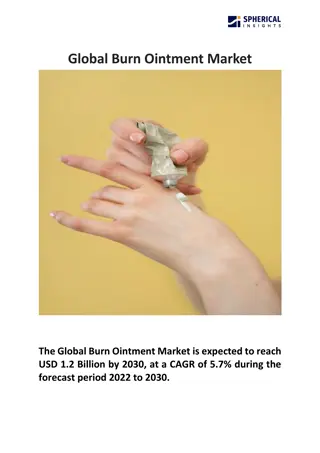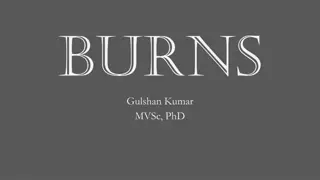Understanding Burn Injuries: Introduction, Classification, Pathophysiology, and Management
Burn injuries can result from various causes such as wet heat, dry heat, electricity, chemicals, and radiation. Understanding the classification, pathophysiology, and management of burn injuries is crucial for effective treatment. Different types of burns, including friction burns, are discussed along with their causative agents and potential complications. Factors affecting burn size estimation and indicators of inhalation injury in chemical burns are also highlighted.
Download Presentation

Please find below an Image/Link to download the presentation.
The content on the website is provided AS IS for your information and personal use only. It may not be sold, licensed, or shared on other websites without obtaining consent from the author. Download presentation by click this link. If you encounter any issues during the download, it is possible that the publisher has removed the file from their server.
E N D
Presentation Transcript
Introduction Classification Pathophysiology Content Complications Management Estimate of burn size
A burn is defined as a coagulative necrosis causing destruction of the epithelium.
Friction Burn Wet Heat Radiation Dry Heat Electricity Chemicals Causative Agents
Wet Heat Commonest type of burn injury Friction Burn 1-Water 2-Steam 3-fat-oil Radiation Dry Heat ( the max temperature u can hold in your hand without throwing the object away is 60 degrees). Electricity Chemicals
Dry Heat 1-Flame : e.g matches, cigarettes, gas . Friction Burn Wet Heat 2-Domestic appliances e.g: irons. Radiation Electricity Chemicals
Chemicals 1-It can be acid or alkali. Friction Burn 2-Degree of injury depends on strength of agent, its concentration and duration of contact with skin. Wet Heat Radiation Dry Heat 3-Risk of absorption and systemic effect. 4-Risk of inhalation of fumes. Electricity
Chemicals Indicators of inhalation injury: In closed space Head, Face, Neck or Chest burn Singed Nasal hair or eyebrow Hoarseness, tachypnea Nasal/Oral mucosa red or dry Soot around mouth or nose Coughing up black sputum (carbon particle). Friction Burn Wet Heat Radiation Dry Heat Electricity
Electrical Effects depend on: Friction Burn 1-Amount of electricity (Voltage) 2-Nature of current (AC or DC) 3-Area of contact 4-Duration of contact Wet Heat Radiation Dry Heat -Dry skin has high resistance. -Wet or sweaty skin has low resistance Chemicals in electrical burns there is an entery wound (small) and an exit wound (large)
Radiation 1-UV light from sun or sunbeds (the commonest) 2-Usually superficial but may be widespread. 3-Post radiotherapy. Friction Burn Wet Heat Dry Heat Electricity Chemicals
Friction Burns E.g RTA When the victim is pulled out of the car , Slides over the road. Wet Heat Radiation Dry Heat Electricity Chemicals
Local Effect: Three Zones within a major burn Zone of coagulation Zone of stasis Zone of Hyperemia
Systemic Effect: The release of cytokines and other inflammatory mediators at the site of injury has a systemic effect once the burn reaches 30% of total body surface area. Cardiovascular changes Capillary permeability is increased, leading to loss of intravascular proteins and fluids into the interstitial compartment., result in systemic hypotension and end organ hypoperfusion. .Immunological changes Non-specific down regulation of the immune response occurs, affecting both cell mediated and humoral pathways.
destruction of epidermis. 1 Superficial burns 1st degree Very painful, dry, red burns due to dilation of dermal capillaries, which blanch with pressure. They usually take 3 to 7 days to heal without scarring. 2 Superficial partial-thickness 2nd degree 3 Deep partial-thickness 2nd degree The most common type of first-degree burn is sunburn. burns are limited to the epidermis, or upper layers of skin. 4 Full thickness 3rd degree First-degree 5 4th degree
Involve epidermis & superficial portion of dermis. Typically, they blister with clear fluid and are moist, red, weeping burns which blanch with pressure . 1 Superficial burns 1st degree 2 Superficial partial-thickness 2nd degree 3 Deep partial-thickness 2nd degree They heal in 7 to 21 days. 4 Full thickness 3rd degree Scarring is usually confined to changes in skin pigment. 5 4th degree
Extend dermis. File:Major-2nd-degree-burn.jpg to reticular Bloody blistering which are non blanching which could be wet or waxy. 1 Superficial burns 1st degree 2 Superficial partial-thickness 2nd degree Their color may range from patchy, cheesy white to red. 3 Deep partial-thickness 2nd degree Less superficial partial thickness burn. painful than 4 Full thickness 3rd degree 5 4th degree They take over 21 days to heal and scarring may be severe, May need grafting.
Whole of the dermis . It is Painless, dry, hard leathery. 1 Superficial burns 1st degree Capillary refill will be absent . 2 Superficial partial-thickness 2nd degree May see coagulated vessels. 3 Deep partial-thickness 2nd degree Skin grafts are necessary. Charred which is black, grey, white or cherry red in colour, hairs not attached, may see thrombosed veins. with eschar 4 Full thickness 3rd degree 5 4th degree
1 Superficial burns 1st degree It is a life threatening injuries. 2 Superficial partial-thickness 2nd degree Extends through skin, subcutaneous tissue and into underlying muscle and bone. 3 Deep partial-thickness 2nd degree 4 Full thickness 3rd degree Dry, painless. 5 4th degree
4.5 4.5 Rule of nines Also known as Wallace s rule of 9. The most common method, but not the best. It is different in children due to their different surface area, they have bigger head and small limbs in proportion to their trunk 18 18 4.5 4.5 4.5 9 9 4.5 4.5 4.5 1 18 1 18 9 9 9 9 7 7 7
Lund an Browder Chart The best and most accurate method. It considers the variation of the surface area according to the age. Is expressed as a percentage of total body surface area. There are 3 variables (A, B and C) which are the areas that their size percentage is affected by growth. Only partial and full thickness burns are included in this estimate of burn size. (A) head (B) thigh (C) lower leg
Rule of Outstretched Hand Gives a rough estimate of the total body surface area. The out stretched patient s hand equals 1%of his body s surface area.
Resuscitation ABC s a)Airway: ensure adequate airway. b)Breathing: Circumferential burns of neck or chest may constrict breathing. Stridor or difficulty breathing indicates endotracheal intubation or ventilation . Prophylactic endotracheal/ nasotracheal intubation in case of: inhalation Injury. supraglottic obstruction. extensive burns > 60%. deep facial burns. facial fracture. Closed head injury with unconsciousness. c)Circulation: Monitor : pulse, BP, failure to maintain adequate circulation may be followed by renal failure and eventually multi-organ failure.
Hx The cause Time and place Age Any chronic illnesses, e.g. DM, HTN..etc Immunization for tetanus ( open wounds), we give immunoglobulins for patients who have never been vaccinated
Exam. Expose patient TOTALLY, remove any burned clothing. Examine generally. Suspect any associated injury. Examine locally at the site of burn: Assess depth (degree) & calculate the size of burn.
Monitor the resuscitation by IV fluids: Fluid replacement is the prime object of initial burn treatment. IV resuscitation is required for any burn patient with; more than 10% of body surface in children or more than 15% of body surface in adult. Assess fluid requirement. To assess fluid requirement we need to identify: 1. 2. 3. Time of burn Patient weight %TBSA involved
Parklands formula: Using Ringer's lactate solution 4ml ringer's lactate x body weight x % of burn = total fluids for 24 hours Give half of the calculated total fluid in first 8. Second and third 8 hrs, give one fourth. In the 2nd day u give colloids..and plasma protien factors..and pottasuim
Muir and Barclay formula: Using colloid with plasma Body weight x % of burn /2 =1 ratio In first 12hours, give 3 ratios. In second 12 hours, Give 2 ratios . In the third 12hours, give 1 ratio.
Modified Brook formula: Using lactate Ringer s solution. In adult at the first day: 2ml/(body weight X %burn) In children at the first day: 3ml/(body weightX%burn) In the second day, to maintain urine output: 0.5 ml colloid x %burn + 5% dextrose water
Maintenance fluid: For adult ; 2-3 liters/day For children A- first 10 kg 100cc/kg B- from 10-20kg 50cc/kg C- above 20kg 20cc/kg
Dressing: The aim of the burn dressing is to keep the wound clean and dry, and prevent infection Two types.
Closed Method Open Method Dressing Types
Leave it exposed Just put such as Flamazine (silver sulphadiazine cream or Mebo ). Used for face or limbs burns (the limb should be elevated to reduce edema). Silver Sulphadiazine is for pseudomonas & not to apply on face ( very irritant !) use MEBO instead . Be careful for silver allergy( they will lose their skin). ointment Open Method Dressing Types
The burn is cleansed with antiseptic solution Covered with silver sulphadiazine cream (antibacterial). Non adherent layer of gauze. Absorbent layer Cotton wool Change the dressing daily or as often as necessary. On each dressing change, remove any loose tissue. Always use Closed dressing except : Face ,hand ,perineum. Closed Method Dressing Types
Burned Hand Dressing Treat burned hands with special care to preserve function. Cover the hands with silver sulfadiazine and place them in loose polythene gloves or bags
Skin Graft Skin grafts are used in treating partial thickness and full thickness burns Early surgical removal (excision or debridement) of burned skin followed by skin grafting reduces the number of days in the hospital and usually improves the function and appearance of the burned area, especially when the face, hands, or feet are involved. Role of grafting: Decrease evaporation & pain. Protects neurovascular tissue & tendons. Prevent facial desiccation & subsequent infection. Prevent scarring ,contracture & deformity.
Types of Skin Graft Autograft (from self). 1. Split-thickness (sheet vs. mesh). 2. Full-thickness. Allograft ( same species i.e. cadaver) Xenograft ( different species i.e. porcine) Skin substitutes ( e.g. cultured keratocytes)
Supportive Care Physiotherapy: from the first day. Analgesia: Methadone. IV morphine for acute pain Don't give analgesia in cases of intracranial or intra abdominal injury (we have to exclude them first) coz it will mask them.
Infection: most serious complication (pneumonia) GI complications: Curling ulcer in 12% of all burn patients (prevented by prophylactic antiacids and H2 blockers) Respiratory complication: major cause of death in burned patient. Hyperkalaemia in the 1st 24 hr because the destruction of RBCs. In the 2nd day there will be hypokalemia due to potassium loss in the urine. Suppurative thrombphlebitis(change iv position in the first 72hours) Circumferential burn relived by escharotomy Cataract. Late Complications: Dyspigmentation . Wound contracture. hypertrophic scar and keloid (in deep parital & post-graft) . Hyperpigmentation .
Greater than 15% burns in an adult, and more than 10% burns in a child . Inhalation injury. Any full thickness or deep dermal burn . Burns of special regions: face, hands, perineum. Circumferential burns . Associated trauma or significant pre-burn illness: e.g. diabetes . Any patients with burns and concomitant trauma (e.g., fractures).























